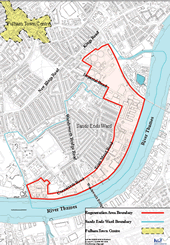Super Sewer Comes One Step Nearer this Week
Thames Water will submit 50,000 page Development Consent application
The Thames Tideway Tunnel, or super sewer, comes one step nearer on February 28 when detailed construction plans developed by Thames Water will be delivered to the Planning Inspectorate.
The Planning Inspectorate is the independent government agency responsible for operating the planning process for what are considered Nationally Significant Infrastructure Projects, or NSIPs.
Thames Water has confirmed it will submit its 50,000 page Development Consent application for the project, which it says is urgently required to help tackle discharges of untreated sewage to the tidal River Thames.
The Inspectorate will decide within 28 days whether the application is a valid one, including for example whether the consultation undertaken was adequate.
If accepted, all the application documents will appear in their own section of the Planning Inspectorate’s National Infrastructure website.
Thames Water will also make them available for scrutiny at six public locations, to be announced next month, along the tunnel’s proposed route, three either side of the river.
The announcement from Thames Water has brought an angry response from Hammersmith and Fulham Council, which has fought a long battle against the project and in particular the choice of a site on Carnwath Road in Fulham as a construction site for the tunnel.
In January, the council approved plans to develop the site, part of which is owner by the council itself, building new homes, offices, shops and leisure facilities, but as it the tunnel is regarded by the government as a " nationally significant infrastructure project" Thames Water said these plans are unlikely to go ahead.
H & F Council Leader, Cllr Nick Botterill says: "We will be pushing the Planning Inspectorate to reject Thames Water’s white elephant but the fact that the elected representatives of London are being side-lined is anti-democratic and is a slap in the face for Londoners.
"It is our view that Thames Water should be considering options for making the river cleaner but we do not believe that a convincing case has been made for this particular scheme. Nor do we believe that alternative options have been properly considered."
Phil Stride, Head of Thames Tideway Tunnel at Thames Water says: " Following a thorough process of public consultation, which started back in September 2010, we have now finalised a highly detailed document, explaining how the project's delivery will be managed.
" It’s the result of many months of work by the team to ensure the application addresses all the relevant legal and technical issues."
Thames Water says if the Inspectorate accepts the application is a valid one, it will appoint an Examining Authority of up to five inspectors to consider any matters arising. As part of this process, interested parties will be able to make representations.
A Preliminary Meeting, open to those who have registered an interest, is expected to take place in early September 2013. Chaired by the Inspectorate, this will determine how the examination will be carried out. This will include consideration of more detailed hearings on site specific matters, as well as project-wide issues.
Once the Planning Inspectorate has concluded its examination of the application, a recommendation on whether or not to grant approval (by issuing a Development Consent Order) will be submitted to Government ministers to make the final decision. This is expected in Autumn 2014.
If consent is granted, preparatory construction work on the project is scheduled to start in 2015, with main tunnelling due to begin in 2016. The target completion date is 2023.
Thames Water says the Thames Tideway Tunnel proposals require a number of construction sites, from Acton in the west to Abbey Mills Pumping Station in Stratford in the east. There the 15-mile tunnel, the deepest and longest ever constructed in the capital, would join up with the Lee Tunnel, already under construction.
Along with separate work also under way to expand the capacity of the five sewage treatment works on the tidal River Thames, the tunnels’ purpose is to tackle the 39 million tonnes of untreated sewage that currently overflows into tidal stretches of the river in a typical year, when the capital’s Victorian sewerage network fills to capacity, sometimes after just 2mm of rainfall.
The tunnels will convey the excess sewage for processing to stringent standards at Beckton Sewage Treatment Works, with green energy being generated from the resulting sludge, before the treated water is returned to the River Thames.
According to Thames Water, all three schemes are needed to ensure the UK meets the requirements of the EU Urban Waste Water Treatment Directive.
February 25, 2013
